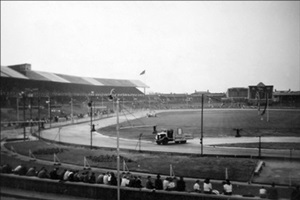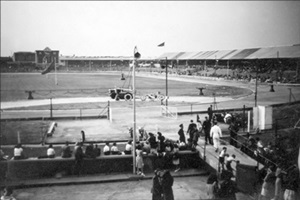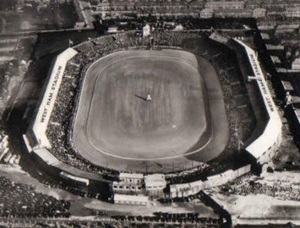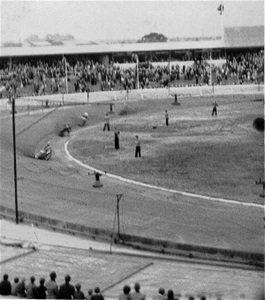
| Home | Contact Us | Articles |
| Books - DVDs | Stadia Pix | Programme Generator |
Custom House Memories
By Geoff Langley
I spent the first 9 years of my life living in a house at 16 Otley Road, which is the street that led down to the main gate of West Ham Stadium and as my dad was speedway fan from pre-war days I was being taken to speedway probably before I was old enough to go to school. I Just caught the end of the Jack Young era and I was then pretty regular from 1964 until the end of Division 1 racing although we had moved away from Otley Road by then, so to me West Ham Stadium and speedway are synonymous.
As kids we used to hang around the main gates waiting for autographs. It seemed there was always someone coming or going, not just on race nights. They even had a full time gateman who had an office next to the main gate who opened and closed the gates to visitors and I suppose logged the comings and goings in his office. How many stadiums are that busy today?
Thinking back it was like a palace to my childhood eyes. A few years ago I went back to the site of the old stadium (now a housing estate of course), sadly there is nothing to suggest a stadium was ever there but what really struck me was that the area was seemed so small.
Race nights were a fantastic atmosphere with long queues at the turnstiles before the gates were opened. I remember people coming along selling bags of Larkins peanuts to fans waiting to go in. I would be interested to know if other fans had the same experience but after the place closed I had terrible withdrawal symptoms and for years I even occasionally dreamed that it was still open and I was there watching the racing.
Regarding the size and shape of the track it was altered over the years. According to my dad in the pre-war years the track length was 440 yards but was shortened when the bends were made wider to accommodate stock cars towards the mid-1950's. The changing shape of the track is evident from these photographs.


There is a concreted arc on the first two bends where you can see the tractor and the Jessup's breakdown truck parked. That is exactly as I remember it, but this next picture, which is an aerial photograph shows no such parking bay for the tractor so I think that must be a pre-war photograph, the picture also shows the words "West Ham Stadium" painted on the roofs of the stands on each side of the track. I don't remember them being there in my lifetime so I guess they must have been removed during the War so enemy aircraft couldn't make a positive identification.

The fact that it is a pre-war photograph makes it very interesting because it shows the original shape of the track. As can be seen the track is pretty much the same width all the way round and the track is almost a square shape with a tight entrance to the bends which then ease out a bit in the middle then have a tighter exit.

Now look at the picture above, which seems almost certainly post-war. The bend seems much more symmetrical but it can also be seen that at the apex of the bend the track is almost twice the width of the straights. That accounts for the shortening of track length.
I was there when Ray Wilson set the track record to 70.2. He outgated Ken McKinlay, and took his front wheel away on the first bend and then had a clear run on a perfect track. I remember Nigel Boocock and Barry Briggs getting round in 70.8 and 70.6 but Ray's record stayed intact to the end.
The slowest race win I ever saw there was 78 seconds dead by Alf Hagon on a waterlogged track in 1964. Anybody remember that?
Incidentally the stadium tractor in the photos was (I think) a Fordson with the name Delilah painted on the front. It was bought new by the stadium in 1936 and was still in use at the end in 1972. It is now owned by a tractor enthusiast who brought it over to Lakeside a couple of years ago.
This article was first published on 6th April 2014

"Lovely article. I can feel the love that Geoff obviously had for Custom House coming through every word. Well written mate! I was never fortunate enough to go to West Ham but the Hammers were a favourite team of mine in the early British League years. I think it was a combination of colours, same as my own Halifax Dukes, the football name association and the riders I so admired; Sverre Harrfeldt, Norman Hunter, Ken McKinlay, Tony Clarke. Not all top rung, I just liked them. Sadly the first time I saw film of racing from Custom House was the report of the very last match with the West Ham Bombers. By the bye, the painting on the roof. Programmes, both speedway and rugby league over the years had Odsal Stadium with two painted stand roofs which changed depending on which brewer was advertising at the time, in other words, the photograph was re-lettered!"
"Such wonderful memories. My first visit to West Ham (and speedway) was in May 1964 at the tender age of 9, to watch the Hammers race against Coventry. To say I was transfixed or obsessed from that first race would be an understatement. My friend Colin and I never really missed a meeting, and when the stadium sadly closed to speedway on May 23rd 1972 we paid a visit a couple of weeks after to view the inevitable demolition. The said gateman was still on duty! He let us in to see our beloved stadium being torn to bits, and gave us a sneak tour around what was left of the speedway office and the baths that many a great titan had washed the cinders and shale off over the years. We are shortly coming up to the 42nd anniversary of the closure. RIP West Ham Stadium."
"I lived in Mortalke Road in Custom House & went to the track for many years 1947 ---1955. Riders I recall Howdy Byford. The Parker brothers, Lloyd Goff, Bluey Wilkinson. What a great time we had, the bikes needed some riding in those days. JAP was the make."
"I am currently making a replica of West Ham Stadium main stand. I love reading about the stadium and I think it is without doubt the best ever built purely for oval sports!
I have a wealth of knowledge on the whole stadium. The photograph in the postcard with 'West Ham Stadium' written on the roof is an old example of photo editing / airbrushing. This photo was taken of the England v Australia test match in 1947. For some reason they edited the photo, removed one of the tracks, put writing on the roof and superimposed more people outside in the car park! Why this was done is unknown but I have the exact same original photo.
Another interesting fact is that the well known photo of first bend action involving riders from England and Australia was taken the exact same day. I am currently obtaining as much info and photos as I possibly can to help me finish model. I will then display it at various events etc.
I currently have a dilemma of whether they were proper seats or simply benches without backs on the upper tier? Also this tier of seating was totally deserted on dog nights... how spooky that must have seemed!
I often wonder if any of the stand survived to be re-erected at another sporting venue and would love pictures of the stadium itself, or being demolished. I have good knowledge of the interior of the stand/ offices but have never seen photos taken from within, any help would be greatly appreciated. Please contact Jason on 07742 024414 or jasontotti@hotmail.co.uk"
"Another piece of info regarding the gent who attended the gates at West Ham....... There is a video similar to the one about the closure of West Ham Speedway and in the video there is footage of the gatekeeper seeing a van out of the premises from I think 1960. It is in colour too. Also in the video is the greyhound starter and chief track an Tommy Lyons...... Such a traditional place"